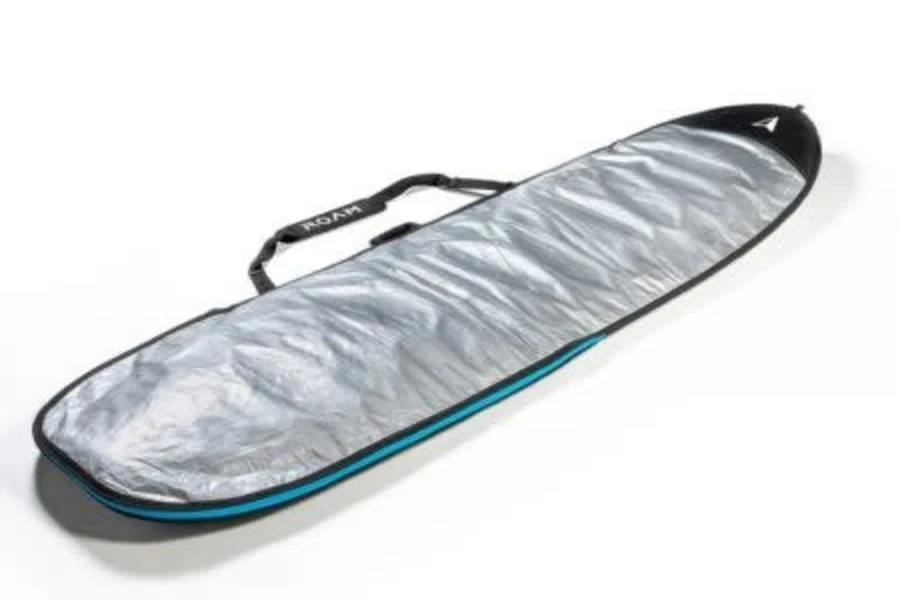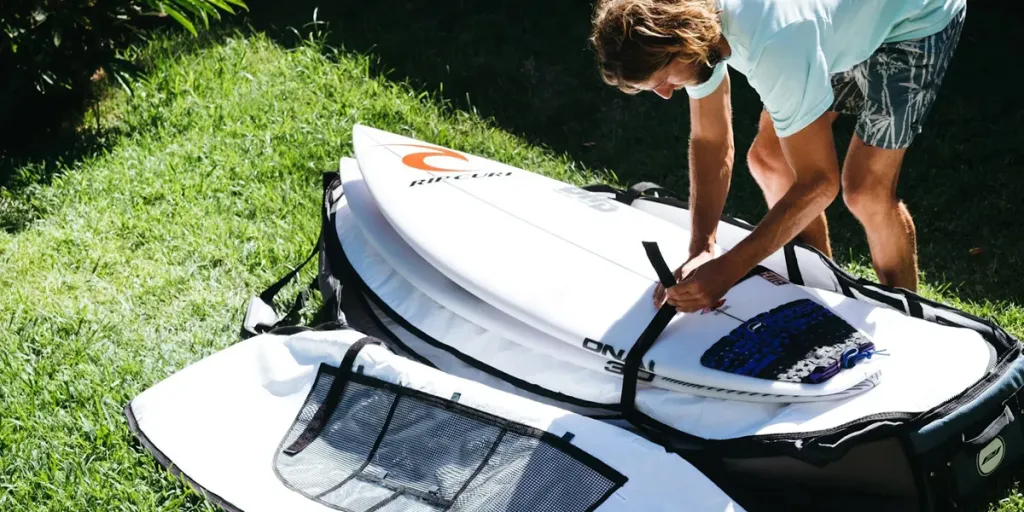Surfboards allow consumers to enjoy one of the most exciting water sports known to man, but they are more fragile than they appear. Leaving boards exposed and open to different elements can quickly shorten their lifespans—and consumers won’t want their boards spoiling on them midsurf!
Whether surfers are driving to the nearest beach or taking longer trips, they must protect their surfboards, and that’s where board bags come in. Surfboard bags help stop any dings and nicks from damaging surfboards! Keep reading to discover more about surfboard bags and what to know before making a purchase in 2024.
Table of Contents
Why is now a good time to enter the board bag market?
Types of board bags
Bonus—surfboard accessory
What to consider before putting board bags up for sale
Bottom line
Why is now a good time to enter the surfboard bag market?
Surfing is probably the most popular watersport on the planet after swimming. Although the waves limit it, many people still enjoy the activity, with research showing that up to 23 million people enjoy surfing! With so many people engaging in surfing, there is a constant demand for surfboard bags, making now the perfect time to jump into the market.
But how good are the market’s stats? Experts rated the surfboard bag market at US $269.73 billion in 2021, expecting it to reach US $388.91 billion by 2028. Forecasts also show the global market will register a 4.57% compound annual growth rate (CAGR) over the forecast period (2022–2028). Product innovation, quality, and variety drive the market’s growth.
Additionally, experts say the rising popularity of DIY surfboards will also push the demand for board bags, propelling market growth. North America emerged as the highest contributor to the surfboard market, while Europe settled as the second-largest segment.
Type of surfboard bags
1. Surfboard day bags

These board bags are the most popular options. Consumers prefer using them for daily use over stretch covers due to their increased protection. The best part is that day bags are still lightweight despite their added thickness (5 to 6 mm). They can easily keep surfboards safe in all travel conditions, except in airports.
Day bags come with a lot of helpful features. For instance, they are made of strong polyester, which makes them very durable. These bags also have white or reflective tarp undersides, allowing them to reflect sunlight and heat while preventing boards from delaminating or wax melting. In addition, day bags offer carry handles and straps. Combined with their lightweight design, day bags are incredibly easy to move around.
2. Travel board bags
These board bags are incredibly similar to their day counterparts but have thicker padding (about 10 mm). This extra padding offers much-needed protection for longer trips, reducing the risk of board damage. Travel board bags may also have inner or outer pockets for other accessories, fin slots, carry handles, full double zips, and shoulder straps with padding.
3. Multi-surfboard travel bags
Think about these variants as travel bags with enough space for up to three extra surfboards. Multi-surfboard travel bags have the necessary durability to withstand the rigors of airline travel. Usually, they come packed with closed-cell foam padding and are equipped with heat-reflective, waterproof outer materials.
Even better, these board bags offer tough, lightweight base wheels, increasing their transportability. Multi-surfboard travel bags are only chunky when consumers must protect more than one surfboard. Interestingly, they can slim down to accommodate only one surfboard, making portability a breeze. And consumers won’t have to worry about their boards moving around inside the bag—they can use internal straps to keep them in place.
Bonus—surfboard accessory
Surfboard stretch covers
Surfboard stretch covers are basically fabric covers. They are the lightest options, offering less than 2 mm of thickness. Usually, stretch covers combine with a surfboard travel bag, but consumers can use them alone to protect their surfboards from light scratches, UV rays, and dust. For convenience, manufacturers also equip them with drawstring closures and polyester nose protectors.
These stretch covers offer enough protection from scratches and dust, especially when surfboards lean against racks. That’s not all! Stretch covers are also great for local surfing and short trips. They’ll help keep consumers’ cars sand- and wax-free.
Note: If consumers want board bags for longer trips, they can use stretch covers as effective extra padding layers. They are great for day bags (on shorter trips) and travel bags (for flights).
What to consider before putting board bags up for sale
Bag shape
Shape is one of the most important aspects of choosing board bags. It determines if the bag will fit the consumer’s surfboard, so offering the wrong shape will lead to sizing issues. Here is a brief look at the different board bag shapes.
| Board bag shape | Description |
| Shortboard bags | These board bags can accommodate shortboards with more pointy noses. |
| Hybrid board bags | These board bags are perfect for standard-shaped shortboards with a little more width. |
| Fish/retro board bags | These boards are the go-to for surfboards with broader general outlines, including wider noses and tails. |
| Longboards | These are the options that can handle the biggest and longest surfboards. |
Size
After choosing the best type for target consumers, the next thing to decide is the perfect board bag size. The answer here is easy: it depends on the consumer’s surfboard (shortboards or longboards). Typically, board bags can host surfboards of the same size or smaller. Check out the table below showing the different surfboard bag sizes and what they can handle.
| Surfboard bag size | Shortboard size range | Longboard size range | Notes |
| 5’10” | 5’4″–5’8″ (19–20″ width) | – | Most popular size for shortboards. It may not fit wider boards. |
| 6’0″ | 5’6″–6’2″ (20–22″ width) | – | Good for fish or mini-mal boards due to their shorter length. |
| 6’3″ | 6’0″–6’6″ (22–24″ width) | – | Accommodates wider shortboards or thicker boards with fins attached. |
| 6’6” | 6’2″–6’8″ (23–25″ width) | – | Good for longboard hybrids or wider shortboards. |
| 7’0″ | 6’6″–7’2″ (24–26″ width) | – | For thicker shortboards or fish surfboards with larger fins. |
| 7’6″ | 6’10″–7’6″ (25–27″ width) | – | Fits wider gun and performance shortboards. |
| 8’0″ | 7’4″–8’0″ (25–28″ width) | – | For longboard hybrids or thicker shortboards with travel fins. |
| 9’0″ | – | 8’6″–9’6″ (22–24″ width) | Standard longboard size. |
| 10’0″ | – | 9’6″–10’6″ (23–25″ width) | Good for larger longboards or noseriders. |
| 11’0″ | – | 10’6″–11’6″ (24–26″ width) | For gun longboards or specialty shapes. |
| 12’0″ | – | Up to 12′ (25–27″ width) | Custom sizes available for larger longboards. |
Thickness
Board bags are usually divided into heavyweight and lightweight bags. Heavyweight bags provide enough padding to keep boards safe during flights. Conversely, lightweight variants are the go-to for shorter commutes. Plus, they often have reflective sides, offering necessary protection without the heavier weight of thicker bags. As implied, choosing bag thickness depends on where consumers want to surf and what protection they need.
- Basic protection (travel within the region): 2 to 5 mm padding thickness.
- Moderate protection (inter-regional travel): 5 to 8 mm padding thickness.
- High protection (international travel or valuable boards: 8 to 12 mm+ padding thickness.
Extra features
Board bags still need some other features to offer the perfect protection. One of these features is the provision for fins. The consumer’s fin configuration determines the feature they will need here. For instance, since quad fins have larger footprints, they will require board bags with extra room at the tail. On the other hand, single fins may need board bags with zippers to allow them to poke through. Pockets are another great option, especially for removable fins and wax.
Speaking of zippers, they must be high-quality! Otherwise, consumers will find scratches on their surfboards or end up looking for replacements due to faulty zippers. Extra internal padding is another protective feature that board bags require, but mostly for travel variants. It helps separate boards from each other to prevent hitting or chafing.
Bottom line
Surfboards are expensive, worthwhile investments, meaning they need the best protection when moving from homes to beaches. Thankfully, board bags have emerged as the perfect way to keep surfboards safe while extending their lifespans.
Modern technology has developed different surfboard shapes and sizes, but following this guide will help sellers offer the best matching options! Leverage this guide to attract a portion of the 8,100 consumers searching for board bags in February 2024.




